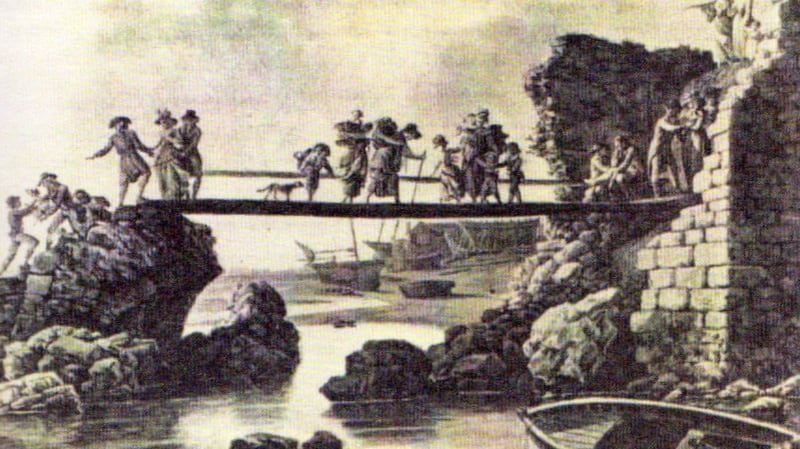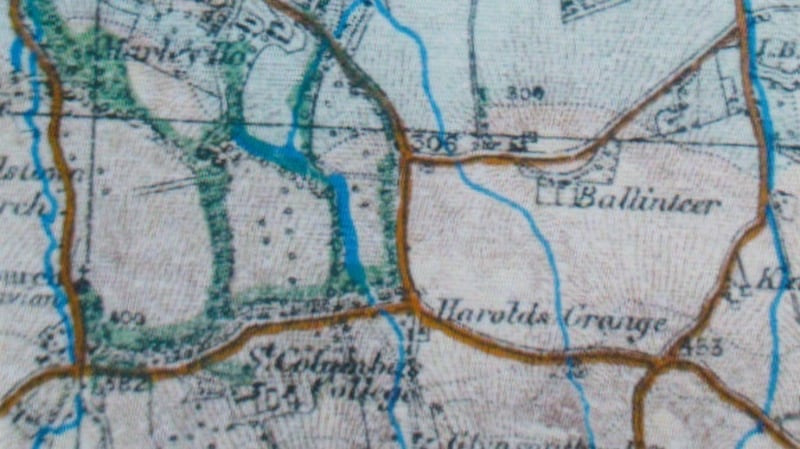The river Dodder runs like a meandering leitmotif through several new books on south Dublin.
On the Banks of the Dodder (O'Brien Press, €29.99) by Ged Walsh explores social and business developments in Rathgar and Churchtown, alongside sepia postcards and old photographs. Evocative illustrations by Michael O'Brien highlight the architectural richness of buildings such as the peculiar Bottle Tower folly on Whitehall Road beside the river. In a drawing of Number 41 Brighton Square – the birthplace of James Joyce – the author's ghost is visible on the path. Attempts to prevent flooding of the river are chronicled.
The Dodder was once described by a resident as a quiet, sluggish stream but often rising during flooding to make a noise like thunder, while the comedian Jimmy O’Dea proclaimed: “Rathgar is a purgatory for souls awaiting the heaven of Foxrock.”
Lives of others whose homes were along the area's leafy roads and tree-lined avenues are charted in From the Grand Canal to the Dodder (History Press, €23) by Beatrice Doran. Many illustrious people occupied the houses, and here 67 lives are covered in detail. While some, such as those in the Baggotonia set, have been well celebrated, it is the forgotten names which fascinate. Agnes Bernelle, for example, was a cabaret artist and musician who recorded with Tom Waits, Elvis Costello and Marianne Faithful.
The Dodder plays a considerable role in Dublin Moving East (Wordwell, €35) by Michael Branagan. Concentrating on the period from 1708 to 1844, the book is filled with remarkable illustrations. During that period the city more than doubled in size and the author discusses what triggered the expansion eastwards. The turbulent river was vital to the capital, providing water and power from Templeogue and Rathfarnham down to the sea, and the walling in of the Dodder helped with flooding and tidying up the area for port activities.

The Corporation saw the potential of the land that could be reclaimed and the additional revenue it would produce. Occasionally, nature altered the course of the river but it was also interfered with by man when it was diverted at Templeogue in 1689. This would prove to be to the detriment of people in the city for the next 120 years.
Numerous watermills flourished along the riverbank and the Dodder was a reliable and free energy source to operate them. This is reflected in Tallaght: A Place with History (€15) by Éamonn Maloney, which considers the work of the paper and flour mills as well as the Old Bawn house and mill. One hundred years ago Tallaght was an isolated rural village but the successful establishment of the Urney chocolate-making factory, with its Tyrone connection, helped boost the economy.
The river and its hinterland were resonant in the lives of poets such as Katharine Tynan and Nora Tynan O’Mahony, while Alice Furlong, with her love of the Irish language, is credited with the first translation of Macbeth into Irish.

The Dodder is placed in topographical context in A Local History of Ballinteer, Co Dublin (Ballinteer Active Retirement Association, €25), edited by Sean Magee. This recounts how the area was transformed from a farming to a suburban society. Brimful of social colour, the information was gleaned from a range of sources by walking the boundary walls or the remains of walled gardens and exploring springs and wells. Streams such as the Ticknock and the Little Dargle, known as riverlets, ran to the mill in Dundrum, both of which flowed into the Dodder.
Away from the river, but still in Dublin, in the mid-1970s John Kelly started work as a 15-year-old copyboy in the sports department of The Irish Times, earning £17 per week. Don't Shoot the Copyboy (€9.99), his memoir of what became a job for life, is filled with the clack of teleprinters and typewriters, burning butts of cigarettes and the banter of office life from a long-gone era.
Kelly’s initial job was a gofer, collecting copy from the Creed Room (also known as the wire room), or running to the nearest cafe for sandwiches and coffee. It was a world of hot metal, galley proofs and “tweedy gentility”, of printers’ protocols and rituals.
Among the sports reporters and subeditors was a bond of friendship with the bogeyman, the stoneman and other staff. Illustrious names included Ned van Esbeck (a rugby fanatic), Paddy Downey (Gaelic games and an authority on the work of Patrick Kavanagh), the “sharp-witted Dub and out-and-out rogue” Peter Byrne (football, athletics and court jester) and Seán Kilfeather, who reported on boxing, and wrote the satirical Fifth Column.
“It was,” Kelly recalls, “where a motley crew of spirited raconteurs, sages, anoraks and eccentrics plied their trade in a dusty Dickensian setting against a backdrop of banter, affectionate abuse and, just occasionally, unaffectionate abuse.”
Paul Clements’s travel book, Shannon Country: A River Journey Through Time, is published by Lilliput Press











